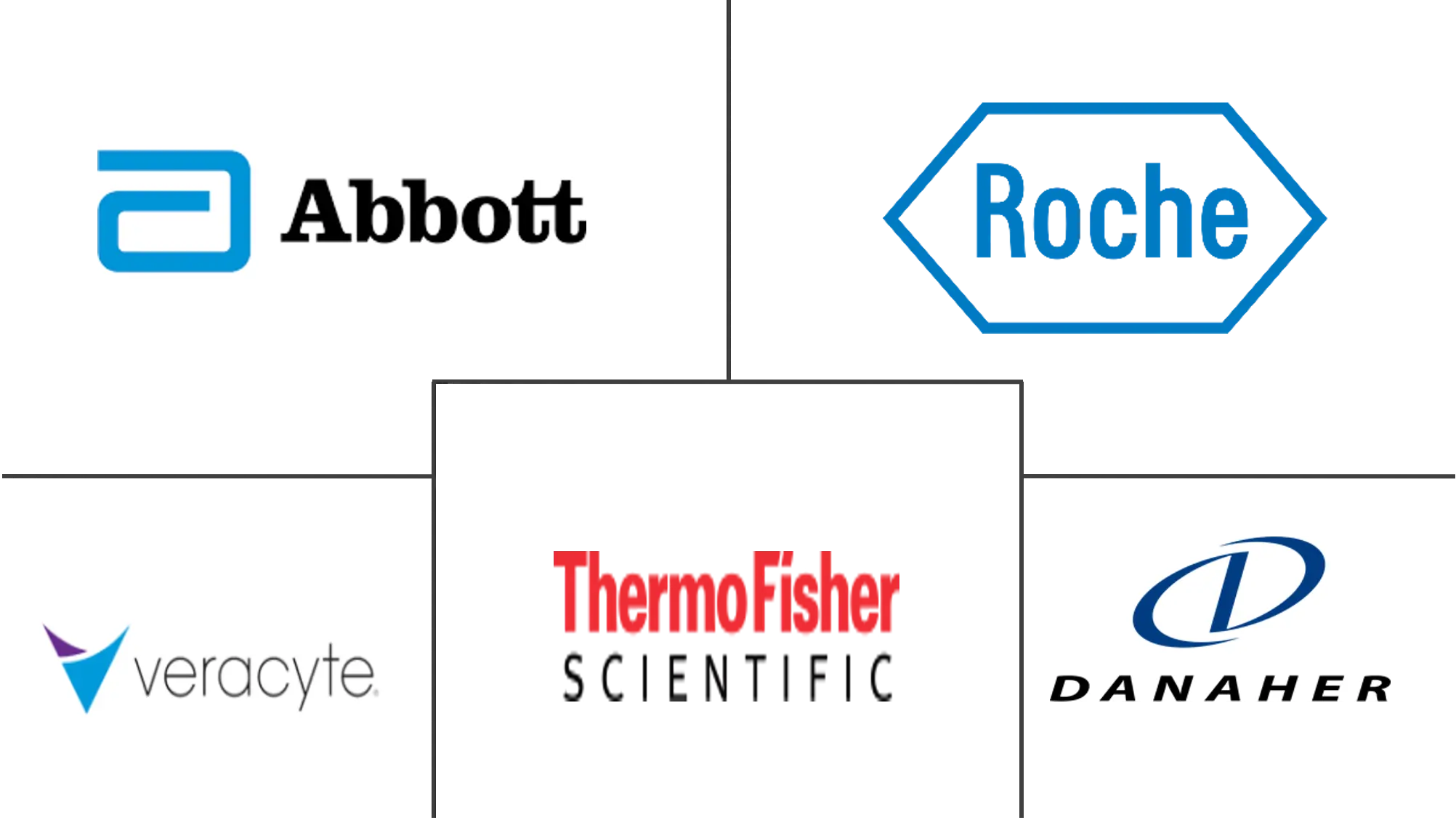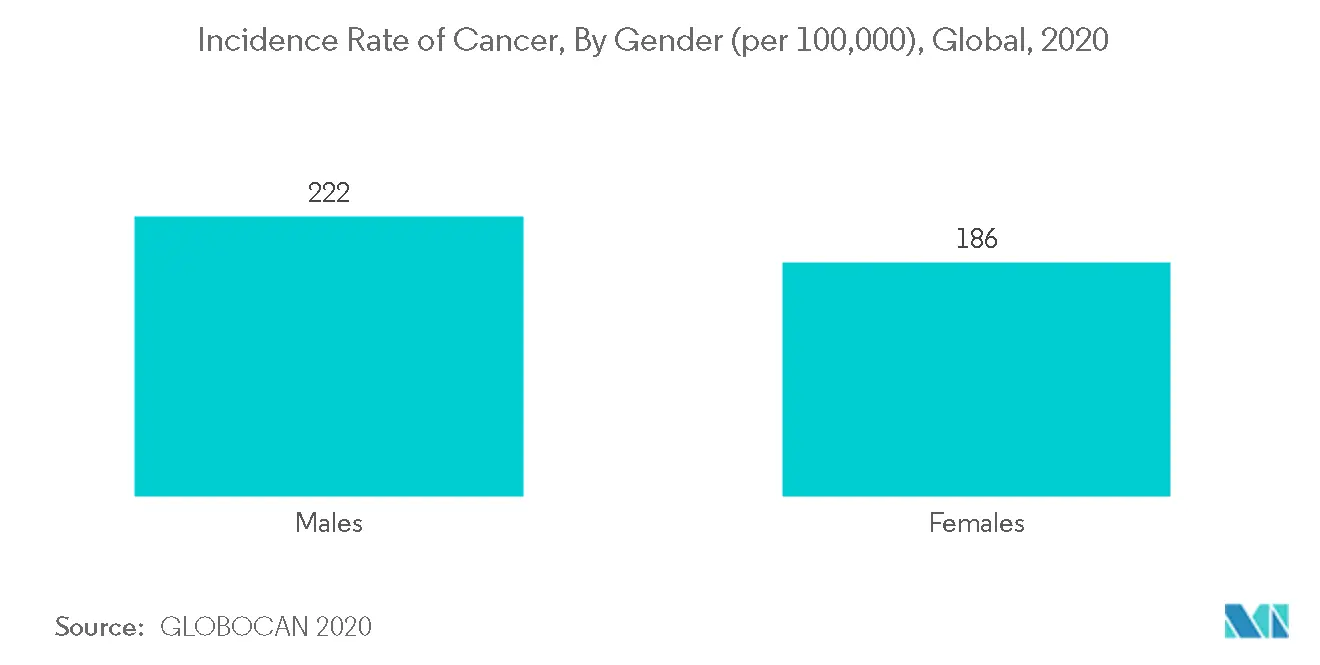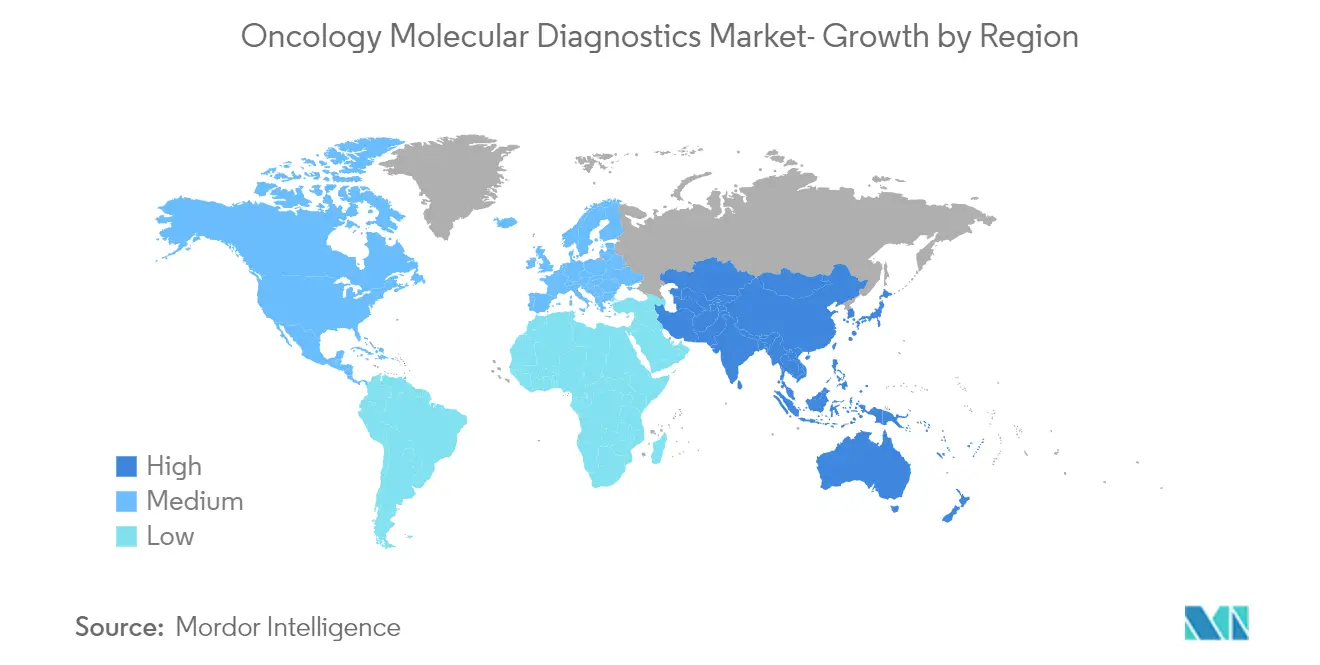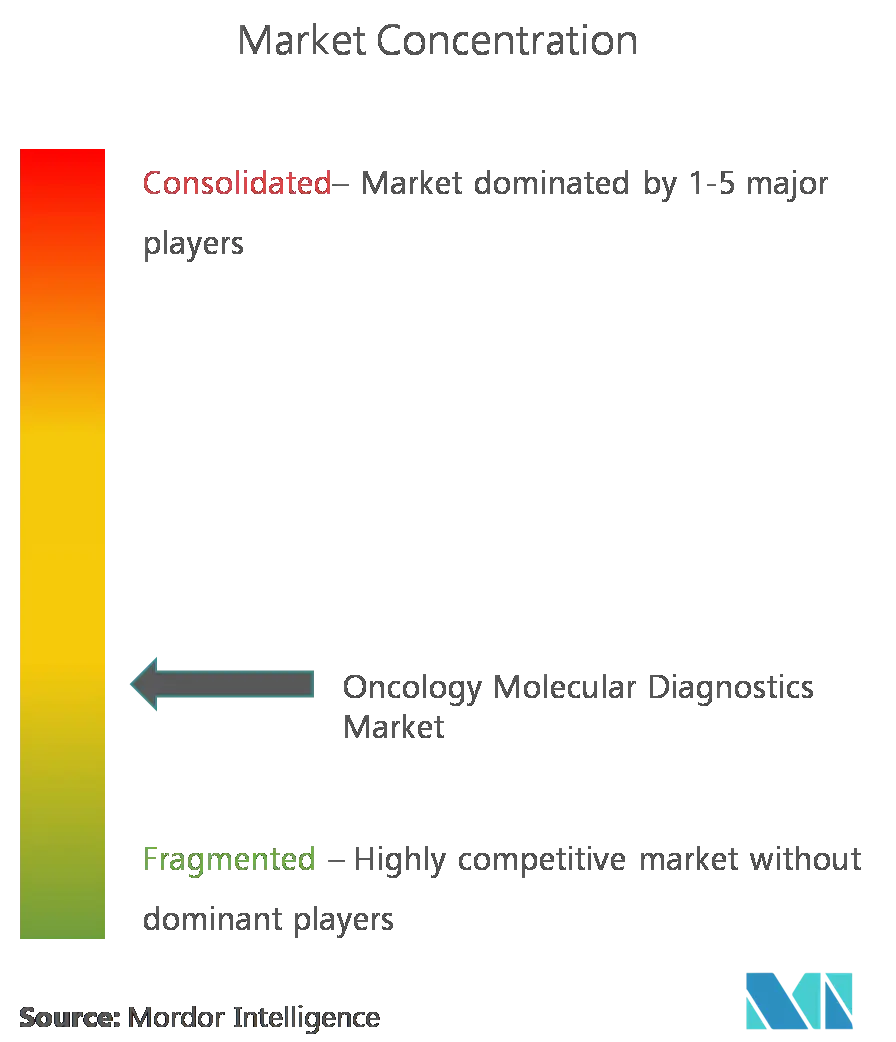Oncology Molecular Diagnostics Market Size

| Study Period | 2019 - 2029 |
| Base Year For Estimation | 2023 |
| CAGR | 12.00 % |
| Fastest Growing Market | Asia-Pacific |
| Largest Market | North America |
| Market Concentration | High |
Major Players
*Disclaimer: Major Players sorted in no particular order |
Oncology Molecular Diagnostics Market Analysis
The oncology molecular diagnostics market is expected to register a CAGR of more than 12 % during the forecast period.
The COVID-19 pandemic has significantly impacted the oncology molecular diagnostics market. As per the Association for Molecular Pathology (AMP), 2021 survey of 163 laboratories, worldwide, 85% of the respondents reported that molecular testing for cancer decreased during April-June 2020. Additionally, more than half of respondents revealed that oncology testing for clinical trials decreased due to lower enrollment, reluctance to travel, and the ability to perform testing. The survey results also indicate that the pandemic may continue to have long-term effects on molecular diagnostic testing for cancer. Additionally, laboratories and universities engaged in the R&D of cancer have witnessed a halt in activities across the world. Moreover, the government funding from various organizations for the research is on hold in several regions of the world.
The growth of the market studied can be largely attributed to the factors, such as the rising prevalence of cancer, worldwide, technological advancements in diagnostic testing, and increasing demand for point-of-care testing. These factors are leading to increasing demand for oncology molecular diagnostics.
The rising prevalence of cancer cases across the world is contributing to the increasing demand for diagnosis, which is boosting the oncology molecular diagnostics market. According to the World Health Organization (WHO), cancer accounted for approximately 10 million deaths in 2020. Additionally, as per the 2021 statistics by the American Cancer Society, by 2040, the global burden of cancer is expected to grow to 27.5 million new cases and 16.3 million cancer deaths. Such high numbers indicate that the estimated rising prevalence of cancer is contributing to the increasing need for early diagnosis and preventive medicine. Thus, in view of the factors mentioned above, the demand for oncology molecular diagnostic tests is consistently increasing.
Additionally, due to the increasing technological advancements in diagnostic testing, there is a growing usage of molecular diagnostics tests for oncology. Several advancements are being made in cancer genome sequencing, computational analysis, tumor models, and innovative cancer research methods. For instance, Roche Molecular Systems, Inc. developed Cobas EGFR Mutation Test for non-small cell lung cancer patients and received approval from the United States Food and Drug Administration (USFDA) in 2020 and is a real-time PCR test to detect 42 mutations of the epidermal growth factor receptor (EGFR) gene. Moreover, in March 2021, Cancer Research UK and Capital Enterprises and Roche UK together launched the Cancer Tech Accelerator program. The new initiative may aid researchers in translating their ideas and lifesaving innovations. Thus, in view of the factors mentioned above, the market is anticipated to witness significant growth over the forecast period.
However, the high cost of molecular diagnostic tests, lack of skilled workforce, and stringent regulatory framework are some of the factors impeding the market growth.
Oncology Molecular Diagnostics Market Trends
This section covers the major market trends shaping the Oncology Molecular Diagnostics Market according to our research experts:
Polymerase Chain Reaction (PCR) is Anticipated to Observe a Significant Growth
Based on technology, polymerase chain reaction (PCR) is anticipated to witness significant growth. Presently, the polymerase chain reaction (PCR) is the most preferred technology for studying cancer. The major factors contributing to the increasing demand for PCR in oncology molecular diagnostics are greater sensitivity, quantification, ease, precision, and reproducibility, better process quality, fast analysis, and lower risk of contamination. It is a sensitive and rapid technique and is ideal for the detection of lymphoid malignancies. Several manufacturers are engaged in developing PCR-based diagnostic instruments and reagents for the detection of cancer. For instance, in June 2021, the AmoyDx Pan Lung Cancer PCR Panel was launched by Amoy Diagnostics Co. Ltd, Riken Genesis Co. Ltd, and Precision Medicine Asia Co. Ltd. It is approved by the Ministry of Health, Labour and Welfare (MHLW) for marketing and production in Japan. Thus, in view of the factors mentioned above, the market is anticipated to grow significantly over the forecast period.

North America is Anticipated to Observe a Significant Growth in Oncology Molecular Diagnostics Market
Within North America, the United States has held a major share of the market. The major factors contributing to the market growth are the presence of many market players engaged in manufacturing and expanding the portfolio of instruments and reagents for molecular diagnostic testing. The region also witnesses the presence of well-established healthcare diagnostic facilities. As per a 2020 report by the American Cancer Society, several professional associations, including the National Comprehensive Cancer Network (NCCN), the American Association of Clinical Oncology (ASCO), and the College of American Pathologists (CAP), have developed biomarker testing and treatment guidelines. Additionally, the increasing prevalence of cancer in the country contributes to the oncology molecular diagnostics market in the region. As per the 2020 Statistics by the National Cancer Institute (NCI), about 1,806,590 cases of cancer were diagnosed in the United States in 2020, and the number of cancer survivors is projected to reach 2.2 million by 2030. Moreover, as per the NCI, in 2021, the most prevalent cancer type is breast cancer, with 284,200 cases. These factors are leading to an increased demand for oncology molecular testing in the region. Thus, in view of the factors mentioned above, the market is expected to witness significant growth in the region over the forecast period.

Oncology Molecular Diagnostics Industry Overview
The oncology molecular diagnostics market is highly fragmented, with the presence of several global and international market players. The key players are adopting different growth strategies to enhance their market presence, such as partnerships, agreements, collaborations, new product launches, geographical expansions, mergers, and acquisitions. Some of the key players in the market are Danaher Corporation (Cepheid), Veracyte Inc, Abbott Laboratories, F-Hoffmann La-Roche Ltd, and Thermo Fisher Scientific Inc.
Oncology Molecular Diagnostics Market Leaders
-
Abbott Laboratories
-
F-Hoffmann La-Roche Ltd
-
Thermo Fisher Scientific Inc.
-
Danaher Corporation (Cepheid)
-
Veracyte Inc.
*Disclaimer: Major Players sorted in no particular order

Oncology Molecular Diagnostics Market News
In December 2020, Veracyte Inc. and Bayer AG collaborated to advance the Precision Oncology Patient Identification Program in thyroid cancer. The development is expected to enable testing with Veracyte's Afirma Xpression Atlas (XA) to identify underlying genomic drivers in tumor cells and may focus on patients with advanced thyroid cancer to benefit from the biomarker-driven therapies.
In February 2020, Danaher (Cepheid) announced a collaboration with Sherlock Biosciences to explore the innovative, ground-breaking molecular diagnostic tests development intended for oncology and infectious diseases deploying CRISPR technology.
Oncology Molecular Diagnostics Market Report - Table of Contents
1. INTRODUCTION
- 1.1 Study Assumptions and Market Definition
- 1.2 Scope of the Study
2. RESEARCH METHODOLOGY
3. EXECUTIVE SUMMARY
4. MARKET DYNAMICS
- 4.1 Market Overview
-
4.2 Market Drivers
- 4.2.1 Rising Prevalence of Cancer Worldwide
- 4.2.2 Technological Advancements in Diagnostic Testing
- 4.2.3 Increasing Demand for Point-of-care Treatment
-
4.3 Market Restraints
- 4.3.1 High Cost of Molecular Diagnostic Tests
- 4.3.2 Lack of Skilled Workforce and Stringent Regulatory Framework
-
4.4 Industry Attractiveness - Porter's Five Forces Analysis
- 4.4.1 Bargaining Power of Buyers/Consumers
- 4.4.2 Bargaining Power of Suppliers
- 4.4.3 Threat of New Entrants
- 4.4.4 Threat of Substitute Products
- 4.4.5 Intensity of Competitive Rivalry
5. MARKET SEGMENTATION
-
5.1 By Product Type
- 5.1.1 Instrument
- 5.1.2 Reagents
- 5.1.3 Other Product Types
-
5.2 By Technology Type
- 5.2.1 Polymerase Chain Reaction (PCR)
- 5.2.2 Isothermal Nucleic Acid Amplification Technology (INAAT)
- 5.2.3 DNA Sequencing and Next-Generation Sequencing
- 5.2.4 In-situ Hybridization
- 5.2.5 Mass Spectrometry
- 5.2.6 Transcription Mediated Amplification (TMA)
- 5.2.7 Chips and Microarrays
- 5.2.8 Other Technology Types
-
5.3 By Application Type
- 5.3.1 Breast Cancer
- 5.3.2 Prostate Cancer
- 5.3.3 Colorectal Cancer
- 5.3.4 Lung Cancer
- 5.3.5 Blood Cancer
- 5.3.6 Liver Cancer
- 5.3.7 Cervical Cancer
- 5.3.8 Other Application Types
-
5.4 By End User
- 5.4.1 Hospitals
- 5.4.2 Diagnostic Centers
- 5.4.3 Other End Users
-
5.5 By Geography
- 5.5.1 North America
- 5.5.1.1 United States
- 5.5.1.2 Canada
- 5.5.1.3 Mexico
- 5.5.2 Europe
- 5.5.2.1 Germany
- 5.5.2.2 United Kingdom
- 5.5.2.3 France
- 5.5.2.4 Italy
- 5.5.2.5 Spain
- 5.5.2.6 Rest of Europe
- 5.5.3 Asia Pacific
- 5.5.3.1 China
- 5.5.3.2 Japan
- 5.5.3.3 India
- 5.5.3.4 Australia
- 5.5.3.5 South Korea
- 5.5.3.6 Rest of Asia Pacific
- 5.5.4 Middle East and Africa
- 5.5.4.1 GCC
- 5.5.4.2 South Africa
- 5.5.4.3 Rest of Middle-East and Africa
- 5.5.5 South America
- 5.5.5.1 Brazil
- 5.5.5.2 Argentina
- 5.5.5.3 Rest of South America
6. COMPETITIVE LANDSCAPE
-
6.1 Company Profiles
- 6.1.1 Abbott Laboratories
- 6.1.2 F. Hoffmann La-Roche Ltd
- 6.1.3 Danaher Corporation (Cepheid)
- 6.1.4 Sysmex Corporation (Sysmex Europe GmbH)
- 6.1.5 Illumina, Inc.
- 6.1.6 Thermo Fisher Scientific Inc.
- 6.1.7 bioMérieux SA
- 6.1.8 Veracyte Inc.
- 6.1.9 Agilient Technologies Inc. (Dako)
- 6.1.10 TBG Diagnostics Limited
- 6.1.11 HTG Molecular Diagnostics Inc.
- 6.1.12 QIAGEN
- *List Not Exhaustive
7. MARKET OPPORTUNITIES AND FUTURE TRENDS
** Subject To AvailablityOncology Molecular Diagnostics Industry Segmentation
As per the scope of the report, oncology molecular diagnostics are tests that detect genetic material, proteins, or related molecules that provide cancer information. The market consists of sales of molecular diagnostic instruments, kits, and reagents for diagnosing cancer. The market is segmented by product type (instrument, reagents, and other product types), technology type (polymerase chain reaction (PCR), isothermal nucleic acid amplification technology (INAAT), DNA sequencing and next-generation sequencing, in situ hybridization, mass spectrometry, transcription-mediated amplification (TMA), chips and microarrays, and other technology types), application type (breast cancer, prostate cancer, colorectal cancer, lung cancer, blood cancer, liver cancer, cervical cancer, and other application types), end user (hospitals, diagnostic centers, and other end users), and geography (North America, Europe, Asia Pacific, Middle-East and Africa, and South America). The market report also covers the estimated market sizes and trends for 17 different countries across major regions, globally. The report offers the value (in USD million) for the above segments.
| By Product Type | Instrument | |
| Reagents | ||
| Other Product Types | ||
| By Technology Type | Polymerase Chain Reaction (PCR) | |
| Isothermal Nucleic Acid Amplification Technology (INAAT) | ||
| DNA Sequencing and Next-Generation Sequencing | ||
| In-situ Hybridization | ||
| Mass Spectrometry | ||
| Transcription Mediated Amplification (TMA) | ||
| Chips and Microarrays | ||
| Other Technology Types | ||
| By Application Type | Breast Cancer | |
| Prostate Cancer | ||
| Colorectal Cancer | ||
| Lung Cancer | ||
| Blood Cancer | ||
| Liver Cancer | ||
| Cervical Cancer | ||
| Other Application Types | ||
| By End User | Hospitals | |
| Diagnostic Centers | ||
| Other End Users | ||
| By Geography | North America | United States |
| Canada | ||
| Mexico | ||
| By Geography | Europe | Germany |
| United Kingdom | ||
| France | ||
| Italy | ||
| Spain | ||
| Rest of Europe | ||
| By Geography | Asia Pacific | China |
| Japan | ||
| India | ||
| Australia | ||
| South Korea | ||
| Rest of Asia Pacific | ||
| By Geography | Middle East and Africa | GCC |
| South Africa | ||
| Rest of Middle-East and Africa | ||
| By Geography | South America | Brazil |
| Argentina | ||
| Rest of South America |
Oncology Molecular Diagnostics Market Research FAQs
What is the current Global Oncology Molecular Diagnostics Market size?
The Global Oncology Molecular Diagnostics Market is projected to register a CAGR of greater than 12% during the forecast period (2024-2029)
Who are the key players in Global Oncology Molecular Diagnostics Market?
Abbott Laboratories, F-Hoffmann La-Roche Ltd, Thermo Fisher Scientific Inc., Danaher Corporation (Cepheid) and Veracyte Inc. are the major companies operating in the Global Oncology Molecular Diagnostics Market.
Which is the fastest growing region in Global Oncology Molecular Diagnostics Market?
Asia-Pacific is estimated to grow at the highest CAGR over the forecast period (2024-2029).
Which region has the biggest share in Global Oncology Molecular Diagnostics Market?
In 2024, the North America accounts for the largest market share in Global Oncology Molecular Diagnostics Market.
What years does this Global Oncology Molecular Diagnostics Market cover?
The report covers the Global Oncology Molecular Diagnostics Market historical market size for years: 2019, 2020, 2021, 2022 and 2023. The report also forecasts the Global Oncology Molecular Diagnostics Market size for years: 2024, 2025, 2026, 2027, 2028 and 2029.
Oncology Molecular Diagnostics Industry Report
Statistics for the 2024 Oncology Molecular Diagnostics market share, size and revenue growth rate, created by Mordor Intelligence™ Industry Reports. Oncology Molecular Diagnostics analysis includes a market forecast outlook to 2029 and historical overview. Get a sample of this industry analysis as a free report PDF download.



